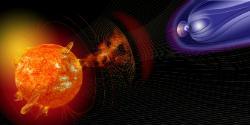How a group of school students discovered the sounds of solar storms

There’s no doubt about it, we are definitely living in the era of “big data”. This isn’t just for companies like Facebook or YouTube, but it also holds true for science too. In the space sciences we have an unprecedented number of satellites and ground-based instruments that monitor Earth’s space environment, routinely producing tonnes of data. While you may have heard about how machine learning, artificial intelligence and algorithms are some of the ways we’re trying to tackle big data, there are some decidedly more human approaches too.
One of the things I study are the sounds within Earth’s protective magnetosphere. Because there are so few particles in space, however, these sounds are incredibly weak and only present at frequencies thousands of times lower than we can hear. But we can make our recordings of them audible simply by amplifying them and dramatically speeding them up. It’s this latter part that can help with big data – you can get through a whole year’s worth of these recordings in just 6 minutes!
Image: https://www.nasa.gov/mission_pages/sunearth/news/storms-on-sun.html
Another way scientists have been trying to cope with big data is citizen science, crowdsourcing volunteers from the public to follow well-defined tasks which help classify or analyse datasets that would prove difficult to do using a computer or a lone scientist. This has proven incredibly successful, for example the Zooniverse platform currently boasts over 1.6 million users with over 375 million classifications. However, with these projects the scientists have to have an idea of what they’re looking for. It’s highly likely though that there are phenomena hidden in the data that currently we’re just missing because we don’t know to look for it yet.
As part of the Research in Schools programme in Queen Mary’s School of Physics & Astronomy, where school students are given the opportunity to experience real research, I devised a project which combined both techniques of dealing with big data in a unique way - having lots of students listening to sounds from space and seeing if anything interesting turned up… and now it has! We’ve just had a study published which reveals the sounds which follow solar storms, found thanks to a group of school students in London.
https://www.youtube.com/watch?v=X6vbST9iMOU
What the students discovered was a loud crunching noise followed by a series of whistling sounds whose pitch decreased. This 5 or 6 second event in the audio corresponded to several days in reality.
By looking into these unexpected sounds in more detail, we found that they started just as a coronal mass ejection or solar storm hit Earth’s magnetosphere, causing a big disturbance. Such disturbances, known as space weather, are important because they can adversely affect our technology such as communications satellites and power grids.
It turned out that the whistling sounds were vibrations of Earth’s magnetic field lines, a bit like the vibrations of a guitar string which form a well-defined note. While the solar storm stripped away much of the material present in Earth’s space environment, as it started to recover following the storm, this started to refill again. It was this refilling that caused the pitch of the sounds to drop slowly over time.
https://www.youtube.com/watch?v=At32mpvw5i0
Previously sounds like this had barely been discussed and therefore were thought to be rare. We could easily test this though with our audible dataset, utilising the amazing abilities of the human auditory system of picking out patterns and signals even when there’s a lot of noise present. What we found is that similar sounds were in fact quite common following numerous other storms.
By looking in more detail at these whistling sounds, we hope to better understand the recovery process of Earth’s magnetosphere following solar storms and other related causes of space weather. This will build up a better picture of what happens and may improve our forecasting.
Making data audible and involving the public can therefore turn up interesting and unexpected scientific results. But that’s not all - it can also create art. Today sees the release of an anthology of short films, created by independent filmmakers from across the globe, all of which were inspired by and incorporate these sounds. You can watch it online for free… and I promise there are no scary Xenomorphs in this one!
https://www.youtube.com/edit?o=U&video_id=P5_OljSnA1k